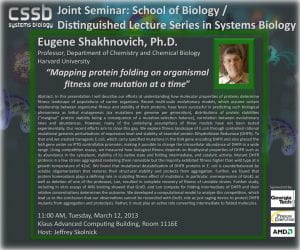 Distinguished Lecture Series Guest Speaker: Eugene Shakhnovich
Distinguished Lecture Series Guest Speaker: Eugene Shakhnovich
Professor
Department of Chemistry and Chemical Biology
Harvard University
Date & Time: Tuesday, March 12, 2013, 11:00AM
Location: Klaus 1116E
Host: Jeffrey Skolnick
Abstract: In this presentation I will describe our efforts at understanding how molecular properties of proteins determine fitness landscape of populations of carrier organisms. Recent multi-scale evolutionary models, which assume certain relationship between organismal fitness and stability of their proteins, have been successful in predicting such biological phenomena as lethal mutagenesis (six mutations per genome per generation), distributions of protein stabilities (‘’marginal’’ protein stability being a consequence of a mutation-selection balance), correlation between evolutionary rates and abundances. However, many of the underlying assumptions of these models have not been tested experimentally. Our recent efforts aim to close this gap. We explore fitness landscape of E.coli through controlled rational mutational genomic perturbations of expression level and stability of essential protein Dihydrofolate Reductase (DHFR). To that end we created transgenic E.coli, which carry specified mutations in the folA gene encoding DHFR and also placed the folA gene under an IPTG controllable promoter, making it possible to change the intracellular abundance of DHFR in a wide range. Using competition essays, we measured how biological fitness depends on Biophysical properties of DHFR such as its abundance in the cytoplasm, stability of its native state and folding intermediate, and catalytic activity. Mutant DHFR proteins in a few strains aggregated rendering them nonviable but the majority exhibited fitness higher than wild type at a growth temperature of 42oC. We found that mutational destabilization of DHFR proteins in E. coli is counterbalanced by soluble oligomerization that restores their structural stability and protects from aggregation. Further, we found that protein homeostasis plays a defining role in sculpting fitness effect of mutations. In particular, overexpression of GroEL as well as deletion of one of the proteases, Lon, resulted in complete recovery of fitness of unviable strains. Further study, including in vitro essays of ANS binding showed that GroEL and Lon compete for folding intermediate of DHFR and their relative concentrations determines the outcome. We developed a computational model to analyze this competition, which lead us to the conclusion that our observations cannot be reconciled with GroEL role as just caging device to protect DHFR mutants from aggregation and proteolysis. Rather, it must play an active role converting intermediate to folded molecules.
Additional Info: The Shakhnovich Biophysics Lab works on a broad range of topics ranging from Molecular Evolution and Origins of Life to Topics in Drug Discovery. The unifying theme of their approach is bottom up where microscopic coarse-grained or atomic resolution models based on statistical mechanics are developed in order to gain fundamental understanding of processes in living matter.
